
Universe Sandbox Roadmap: 2020 & Beyond
Apr 30th
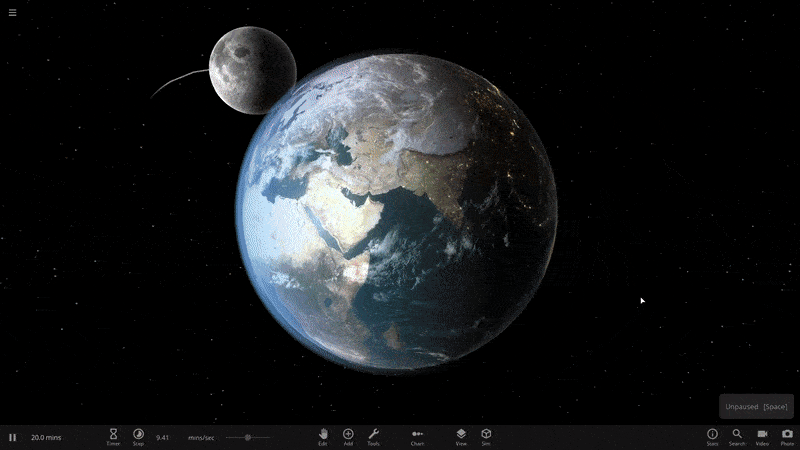
Universe Sandbox has improved significantly since our first Early Access release in 2015. We plan to add features and fix bugs for a long, long time to come (we even removed the “2” from our name for that reason). Here’s a look into what we have planned for 2020 and beyond.
What did we do in 2019?
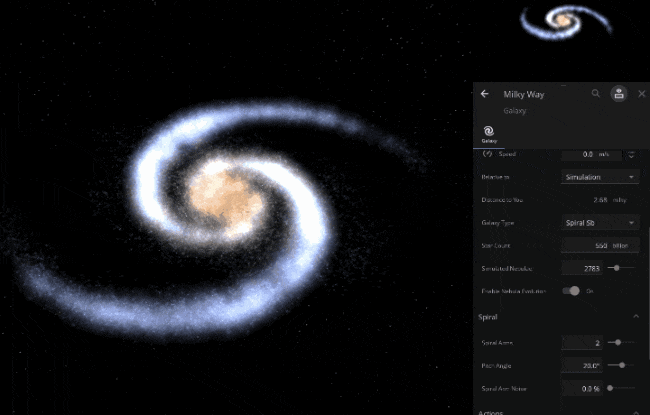
Last year saw 3 major feature releases (and a handful of minor, but still important, updates):
- Better Galaxies (Update 23)
- More stable and accurate galaxies and better collisions
- New and improved Introduction tutorial for helping new users
- Surface Grids & Lasers (Update 24)
- Surface Grids is a huge, complex feature that simulates the surfaces of planets, moons, and other objects
- Vaporize entire planets with the new Laser tool
- Custom Object Colors (Update 24.1)
- Customize colors for just about every object including planets, moons, stars, and black holes
- Dock graph windows alongside the other panels added with Surface Grids
View our “What’s New” for a chronological list of changes.
What’s the Plan for 2020?
The following list are all things we are working on currently. We’re aiming to deliver on all of this in 2020, but when they’ll be ready is difficult to predict, and priorities can change.
With its ability to simulate localized surface temperatures, water level, vapor content, and more, Surface Grids (Update 24) perfectly sets us up for a multitude of new features. Localized temperatures enabled us to create the mighty Galactic Empire Superlaser, but that’s only scratching the surface…
Surface Grids Improvements
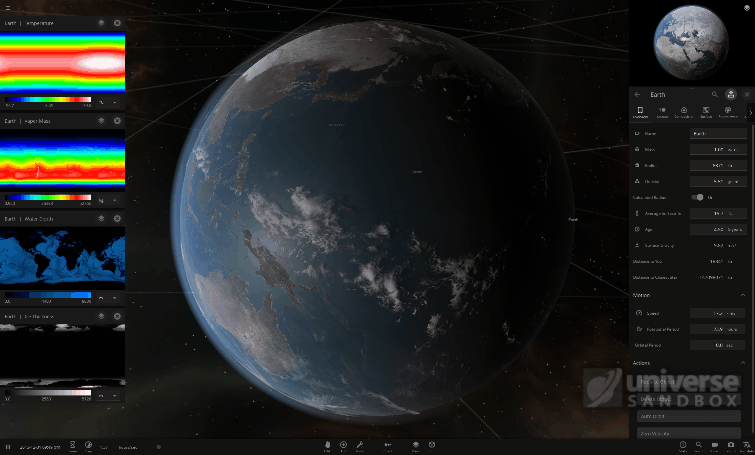
We’ve been saying that Surface Grids is the foundation for many things to come, so it only makes sense that we start the year off by further improving it.
- Improved Temperature & Atmosphere Simulation
- Surface Grids improvements started this year in January (Update 24.1.2), continued with Update 25 (March 2020), and will be a theme all year long
- Update 25 introduced a major rewrite to Tidal Heating and Vapor Flow calculations
- Better Performance & More Power
- Not only have we accomplished localized surface simulations on your everyday computer, but we continue to make performance improvements
- Shader Model 5.0, a graphics card technology, became a requirement in Update 25 because it will give us some legroom for current and future enhancements
- Detailed Surface Manipulation
- We are in the early stages of designing tools that allow for directly manipulating temperature, elevation, water level, vapor, and more on the surfaces of objects
- We plan to add the ability to view and edit the properties of individual surface grid “cells”. Take your planet customization and terraforming to a new heights with a level of precision you never thought possible
Material Composition System
Building off of the localized materials (water, CO2) in Surface Grids, we’re working to rebuild our material composition in a more robust way.
- Better System to Unify Materials
- Every point on the “grid” will better contain a mixture of various materials, in various material states
- Complicated calculations of, for example, when some liquids become heated to a gas, should be handled more efficiently in our new simulation code
- A Universe of Possibility
- Better terraforming, more realistic cloud and climate simulations, tidal waves, easy ways to manipulate the surface topography, and more detail on the surface view could all be the results of this new Material Composition System
- Who knows, maybe our planets could one-day support life?
Full Desktop User Experience in VR
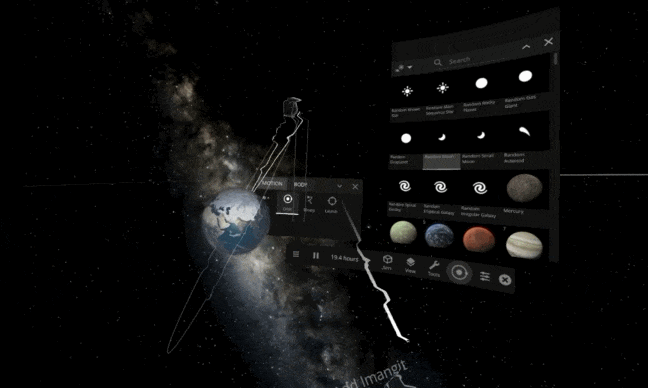
We have embraced a seemingly impossible goal of having a unified Universe Sandbox release no matter how you play. Whether you are on a powerful gaming PC, a laptop, a phone (coming soon), Virtual Reality, Mixed Reality, or a console (maybe soon? who knows!) the experience should be undiluted and awe-inspiring.
- A Magic Leap Forward
- With our recent Magic Leap 1 release, we were able to bring the full Desktop experience to the world of Mixed Reality
- Hard work pays off: the bulk of our Magic Leap 1 development helped unify our Mixed Reality, VR, and Desktop experience into one single vision
- Get Your Hands on it
- Enjoy Universe Sandbox in VR without limitations and with the full Desktop User Interface
- Grab planets with your hands, shoot lasers out of your fingertips, and watch galaxies collide as if you were really there, floating in space (but a bit less cold).
User Interface Improvements
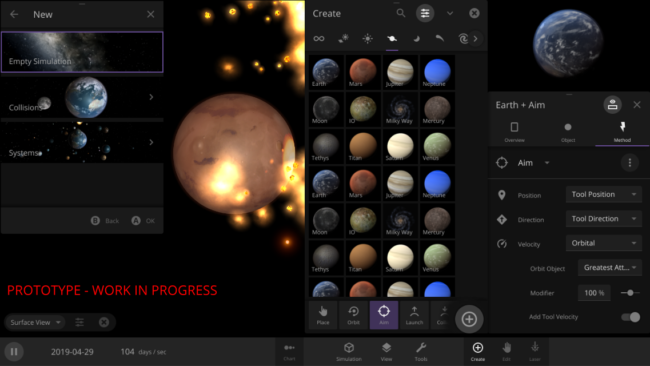
Creating the user interface (UI) for Universe Sandbox is a fun challenge. How do you give someone full control of the universe? As we add features and complexity to the simulation, keeping the UI accessible, discoverable, and easy to use becomes a constant challenge.
Over time, some portions of the interface can start to feel cluttered or outdated and are ready for a redesign. We’ve been working on some of these design changes for a long time, and it’s exciting to move closer to improving everyone’s experience with Universe Sandbox.
- Redesigned Bottom Bar
- Our current bottom bar has been collecting new buttons over the years without a cohesive vision for how it should all work. So we’ve rethought how everything should be organized and how we can make it work on really small screens.
- Improved Add Panel
- Like the Bottom Bar, the Add Panel is due for a makeover. We’re targeting a single shared UI for all platforms (desktop, touch, VR/AR, and consoles), so the new Add Panel is being built with that in mind.
…and beyond?
Mobile
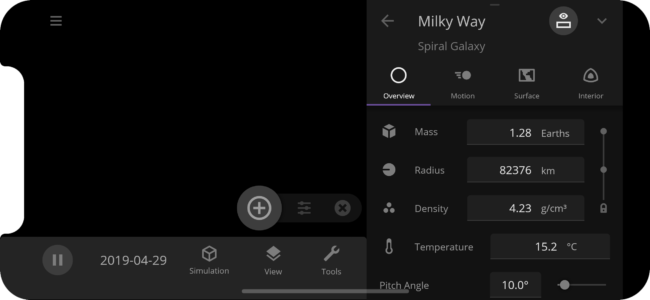
Enjoy Universe Sandbox on your phone or tablet! Sign up to get notified about our mobile version.
- Is that Universe Sandbox in Your Pocket?
- Our mobile version is in development right now for both Android and iOS. It’s no easy feat to simulate the universe on a smartphone, but we’re doing it!
- A Pure, Unadulterated Experience
- Some of the breakthroughs we made with both Surface Grids and Magic Leap have paid off and will allow for the full desktop version on your pocket-sized device
Life Simulation
Create the right conditions for life and watch it grow, or end it all with a major impact.
- Turn a cold, lifeless space rock into a vibrant planet
- Many details are still TBD, keep an eye out for a DevLog when we get started
Fluid Simulation

Smoothed-particle Hydrodynamics (SPH) will help create more detailed, realistic simulations of collisions, fragmentation, and formation of different types of objects. Read more in our SPH Fluid Simulation DevLog.
Experiments with Tools

This is firmly in the realm of experimentation at the moment, but we’re looking at new and interesting ways we can use our tools within a simulation. Driven by a need to automate testing of features, we’re working on ways to programmatically activate tools. By automating and attaching different tools to objects, we discovered that we can enable some pretty fun scenarios. The above clip is what happens when we attached a bunch of lasers to moons and tell it to automatically fire at the nearest object. Awesome stuff, right?
Gamepad Support… and more?
Do you want to sit back on your couch and play Universe Sandbox? So do we! We’ll be experimenting with full gamepad support. Who knows where that leads us, maybe even a console version in the future.
Hiring
We are currently hiring a Spaceship Physics Developer, join us!

Light It Up | Update 25.1
Apr 20th
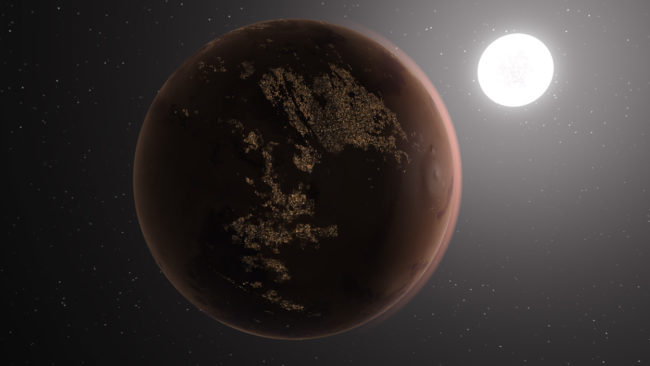
Run Steam to download Update 25, or buy Universe Sandbox via our website or the Steam Store.
Update 25.1 includes a host of bug fixes and lighting improvements, as well as a fun oft-requested feature to add customizable city lights to any rocky planet or large moon.
City Lights on Any Planet
You can now enable City Lights on any rocky planet or large moon by going to Object Properties > Appearance > City Lights. Select from Earth’s city map or a randomized procedural map, and define whether the lights will turn off if the surface is deemed uninhabitable.
Lighting Improvements
The interaction of multiple light sources has been reworked, particularly with how they reflect off an atmosphere.
General Fixes
We fixed a bunch of miscellaneous issues, including improving how supernova clouds impact objects, star temperature instability, orbit previews, shadows, and more.
Please report any issues on our forum, on Discord, or in-game via Home > Send Feedback.
I Like My Heat Tidal | Update 25
Mar 13th

Run Steam to download Update 25, or buy Universe Sandbox via our website or the Steam Store.
Update 25 brings significant improvements to our temperature and surface simulation, adding stability and accuracy, drastically improving speed, new object properties, and a rewrite to our tidal heating model. We’ve also added some often-requested features such as “Replace Object” and graph data export, as well as relocating save data associated with removing the “²” from “Universe Sandbox”.
Major Surface Simulation Performance Improvements
Moving from Shader Model 3 to 5, a feature of most modern graphics cards, allowed us to utilize new technology (compute shaders), lowering the video memory requirements of the surface simulation by almost half and increasing performance substantially. Moving forward, this will allow us to add additional complexity to surface grids, better collisions (using smoothed-particle hydrodynamics), and gorgeous graphical features. Because of this change, we have updated our minimum system requirements.
Temperature & Atmosphere Rewrite
Tidal heating and temperature calculations have just received a major rewrite. This includes significant improvements to vapor flow, atmosphere energy retention, and overall object energy absorption and radiation. You can see these properties in action in the new Energy Flow section in an object’s Surface tab, and in our new Energy and Heating guides.
Hot-swappable Celestial Object
A “Replace Object” button has been added to the Properties panel. This will allow you to hot-swap any object in the simulation for any other object, enabling a bunch of fun scenarios that were hard to do in the past.
The “²” is Silent
Just call us “Universe Sandbox”, we’ve gotten rid of the “²”. When loading the update for the first time, you may notice a “Migrating Data” message. We’re automatically reorganizing settings and saved files to reflect the name change.

Check out the full list of What’s New in Update 25
Universe Sandbox 2019 Retrospective
Feb 25th
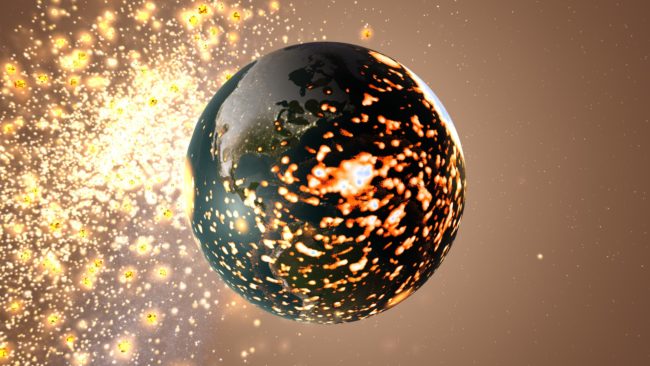
While there’s a lot to look forward to in 2020, we’re going to take a moment to celebrate the milestones we reached this past year.
1
New team member.
Brendan is a graphics developer from Australia and is joining Georg in making everything in the universe beautiful, awesome, and graphically performant. He’s already worked on improving random planet generation, fixing black hole issues on the Magic Leap, and is now creating visuals for our experimental liquid planets project, AKA smoothed-particle hydrodynamics (SPH).
2
Number of full-time developers on a new platform.
Magic Leap 1! We started a new journey into augmented reality in 2019 and we’re really proud of the work we’ve done to bring the full power of Universe Sandbox to Magic Leap as an undiluted experience. Dave and Jacob focused most of the year on Magic Leap with support from the rest of the team.
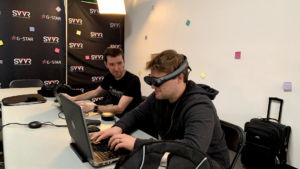
Universe Sandbox creator & director, Dan Dixon, working on Magic Leap with developer Dave Nelson.
4
New human-sized objects.
- banana
- watermelon
- sword
- sledgehammer
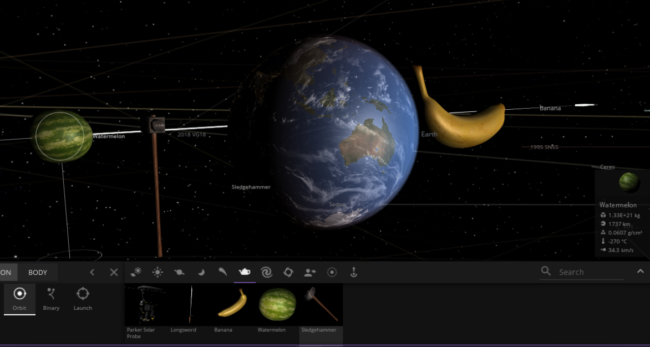
Everything you need to make a very bad fruit salad.
7
Significant updates to Universe Sandbox.
- Revamped Vapor & Engine Experiments | Update 22.2 | April 10, 2019
- A Big Day for Physics | Update 22.3 | May 30, 2019
- Beyond the Milky Way | Update 23 | June 25, 2019
- Galactic Clean-Up | Update 23.1 | August 20, 2019
- Saturn’s New Moons | Update 23.2 | November 01, 2019
- Surface Grids & Lasers | Update 24 | November 22, 2019
- The Color in Space | Update 24.1 | December 19, 2019
This year had a mix of improving existing content and rolling out new features. While there were fewer objects added, several key systems got revamped (see Surface Grids), setting the team up for exciting additions in the coming year.
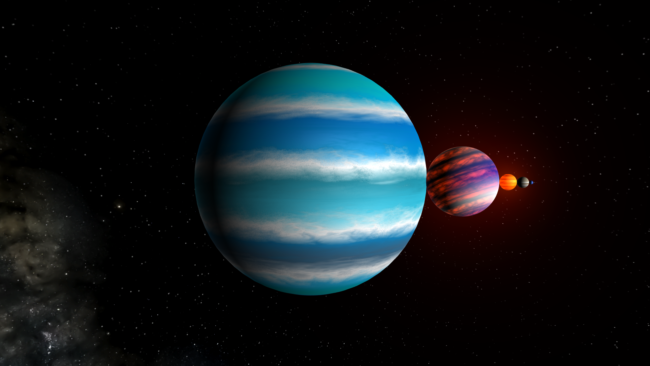
Image provided by Discord user Mangolia.
28
# of languages we now support, up from 22 last year.
A big thanks to our community for helping with our crowdsourced translation efforts! Want to help translate Universe Sandbox into your native language? Learn more.
| Bulgarian | Chinese Simplified | Chinese Traditional | Czech | Danish |
| Dutch | English | Filipino | Finnish | French |
| German | Greek | Hungarian | Indonesian | Italian |
| Japanese | Korean | Norwegian | Polish | Portuguese |
| Romanian | Russian | Spanish | Swedish | Thai |
| Turkish | Ukrainian | Vietnamese |
601
Highest number of concurrent users in Universe Sandbox in 2019.
This is higher than in 2018, and second only to our all-time high of 617 players in March of 2016, during our first big Steam sale.
1,963
# of users in our Discord server.
2,124
# of positive Steam reviews in 2019.
Seeing so much love for Universe Sandbox warms our hearts the way gravitational squishing heats Io.
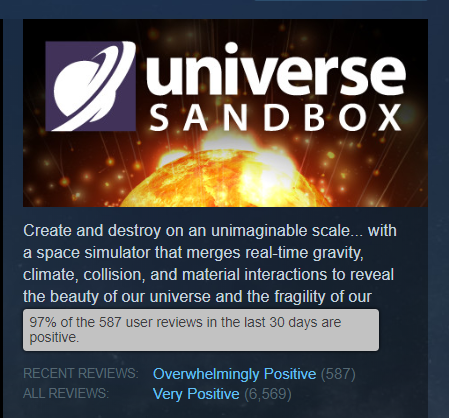
Overwhelmingly Positive reviews. Wow!
2403
# of code commits (changes) made to the Universe Sandbox project in 2019.

A look at our GitHub commits activity since 2015. The gray section shows 2019.
14,893
# of shared items in the Universe Sandbox Steam Workshop.
This is over six times as many as 2018! We can’t wait to see how this library of community creations grows in the coming year! To get through all of them in 2020, you’d have to check out slightly more than 40 per day. (Get cracking?)
103,541
# of messages sent on Slack (an instant messaging platform we use to communicate).
Giant Army is a completely remote team, with some dozen members on three continents. We also use Google Meet for our face to face video meetings but much of our work happens in text.
163,298
# of units sold on Steam.
In 2018, we sold a copy just about every five minutes. In 2019, that interval narrowed to a little under 3 minutes and 15 seconds.
474,811
Lasers equipped since our Surface Grids & Lasers release.
This is one of the stats we track using our built-in analytics.

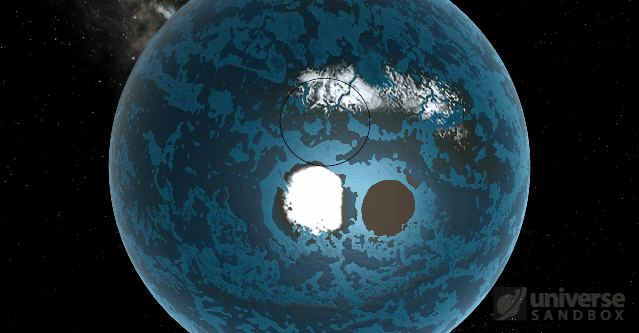
The magic cold laser in action. Image provided by Discord user Anonymoose/BlueMarble.
8,093,789
# of views on most viewed Universe Sandbox video of the year.
We’ve been delighted to see GreyStillPlays make 26 videos featuring antics in Universe Sandbox.
10,485,760
# of individual data points we are simultaneously simulating on object surfaces.
This is our Surface Grid system, which is a foundation that we’ve been working on for years, and will enable us to skyrocket into the future with some pretty exciting features. More on that soon in the 2020 roadmap.
(with atlas resolution of 1024 × 2048 × 5 layers = 10,485,760 | higher-end computers can simulate 2048× 4096 × 5 layers = 41,943,040 points).
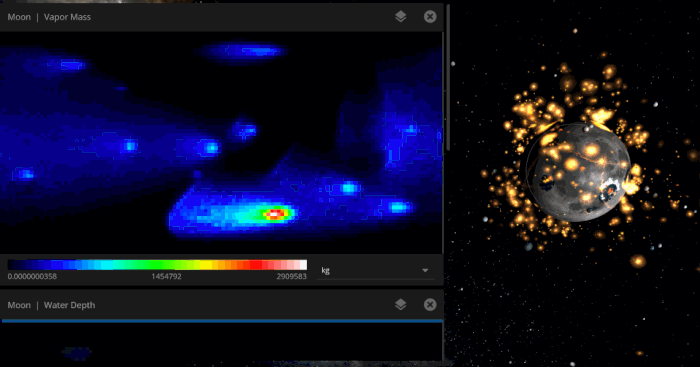
Vapor content on the Moon as it is bombarded by icy asteroids
What’s next?
Improvements to heat and material simulation across object surfaces, new tools, life simulation, better performance, data analysis, Magic Leap, a completely revamped VR experience, SPH – it’s hard to list it all. The foundational work we did in 2019 sets us up to do amazing things in the coming year.
Stay tuned for a 2020 roadmap, which we’ll publish next.
Thank you to everyone, to both new players and those who have been playing Universe Sandbox for years. Whether you’re analyzing orbits, creating fictional worlds, learning about astronomical material properties, or just having fun throwing planets together, we truly couldn’t do this without your continued enthusiasm for our little astronomy simulation. And we’re just getting started.
The Universe Sandbox Team
Dan, Chris, Georg, Alexander, Jonathan, Dave, Rappo, Mat, Jacob, Erika, and Brendan
The Color in Space | Update 24.1
Dec 19th

December 20: Update 24.1.1 is a small patch that fixes a handful of bugs, including issues with gas giant band order and lighting for custom star colors.
Run Steam to download Update 24.1, or buy Universe Sandbox on Steam where it is 33% off until January 2, 2020.
Customize Those Colors
Customize colors for just about every object in the new Appearance tab. Add dozens of bands to gas giants, turn Earth’s atmosphere red, or color your alien star purple. We aim for realism in Universe Sandbox, but that doesn’t mean we can’t also allow for creativity.
Dock Those Graphs
Graphs are now docked alongside the other view panels added with Surface Grids, making it easy to keep your eye on data for different objects and properties as graphs, maps, and surface views.
Launch That …Sword?
We added a sword. Don’t think about this one too much. Add > Objects > Longsword
This update also improves black hole visuals, makes it possible to view Surface Grids data directly on an object’s surface, and adds a bunch of smaller improvements and bug fixes.
The name of this update is an homage to the H.P. Lovecraft sci-fi short story The Color Out of Space. A film adaptation of the same name, starring Nicolas Cage and coming to theaters in January 2020, features a scene with a character playing Universe Sandbox. Catch a glimpse of it in the trailer at the 0:17 mark!
Check out a full list of What’s New in Update 24.1
Happy holidays!
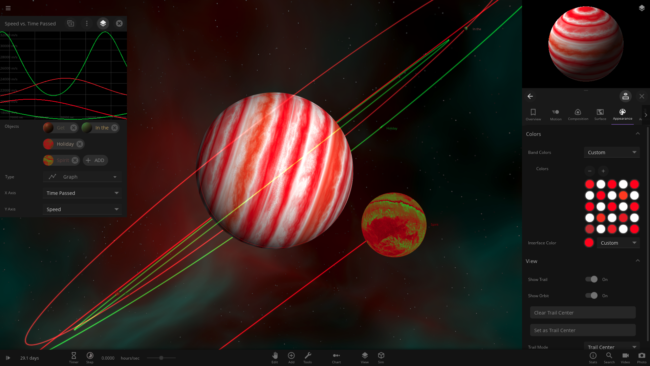
SPH Fluid Simulation | DevLog
Dec 13th

Video: Simulating a planetary collision using a new method called smoothed-particle hydrodynamics (SPH).
Hopefully by now you’ve had time to check out Surface Grids & Lasers | Update 24 of Universe Sandbox. If you haven’t, time to get out from that rock you’ve been living under and start terraforming all those other rocks floating through space.
We plan to continue to add to the Surface Grids feature with even more detailed surface simulation through next year and beyond. Surface Grids is a massive new feature that changes a lot with the core simulation of objects in Universe Sandbox, and so far we’ve just scratched the surface of what it can do. We’re excited to explore its possibilities even more.
But right now, let’s turn our attention to something our physics developer, Alexander, has been working on. Introducing… smoothed-particle hydrodynamic fluid simulation. Let’s just call it SPH for now.
SPH is NOT included in Universe Sandbox yet. This is a behind-the-scenes look at a feature that we are still working on.
What is SPH and how does it work?
For a deep dive into the mechanics of SPH, check out this paper from our very own physics developer, written back in 2010 (interestingly, not written in relation to Universe Sandbox, but for another project that was similar in many ways — there’s a reason why we hired him many years ago to help build this new version of Universe Sandbox, and it had more to do with relevant experience than it did with his propensity for typos… *wink*).
Or if you’re curious about SPH, but perhaps not curious enough to read 35 pages on it, here’s a crash course:
SPH is a computational method commonly used for modeling fluids (though it can also handle solids). That might make you think that we’d use this for simulating something like water flow on a planet’s surface, but “fluid” here actually has more to do with simulating much larger objects.
On an astronomical scale, many of the objects you can simulate, like stars and galaxies, behave like fluids. This is also true for planets, whether it’s a gas giant or a rocky planet with, or even without, a molten core. And even in the case of large chunks of solid rock colliding with each other, there is such intense temperature and pressure that the materials behave more like fluid rather than rigid solids: they’ll stretch and distort and be torn apart, rather than splinter, crack, and shatter.
So in short, SPH will help create more detailed, realistic simulations of collisions, fragmentation, and formation of different types of objects in Universe Sandbox.
How? First, the material, such as a planet, is broken into a number of “particles” that each have properties such as mass, temperature, velocity, and position. You can see these particles clearly in any of the videos in this post.
But the “smoothed” part of “smoothed-particle hydrodynamics” means that these particles are just sample points of what is actually a continuous material, where they each contribute to the properties at a given point based on a weighted, smoothed, average. Together, they describe the properties that exist at any given point in a flow of material, but they themselves are not the material. Think of it like buoys in an ocean: the buoys will each monitor the properties at their location, and they are distinct from the continuous fluid, ie the ocean, that they are monitoring. So for the future of SPH in Universe Sandbox, the current debugging visuals, where you can see individual particles, will ideally be replaced by something that better represents the continuous fluid that is actually being modeled.
By tracking how each of these particles move, and more importantly how they move in relation to their neighbors, you can calculate pressure and viscosity (friction) at any point in
the fluid. And then you can estimate how this will move over time under different forces. Combine this with gravity and you start to see a simulation with emergent behavior that matches what we observe in real life.
Why SPH?
Because you get accurate simulation with emergent behavior, rather than disparate modeling of phenomena that needs to be stitched together. For example, with SPH, material will collect under the influence of gravity, but it will not all fall to the center of mass. Instead, as more material collects, the pressure increases and starts pushing out material, preventing a total collapse. The result is a spherical shape, and not because we specifically told it to become a sphere, but because that’s what happens when you simulate physics on a more granular level.
Or look at the case of Roche fragmentation, where a moon may be torn apart from the gravity of its host object “pulling” more on its near side than its far side. In our current simulation, pre-SPH, where we model how single points of mass move purely under the influence of gravity, we need special handling to calculate when and how this should happen, according to analytical models. But with SPH, this phenomenon just happens as the result of forces acting on the moon.
Why SPH specifically and not another method? When simulating space, there is more literal space than there is simulated material. SPH is great for handling cases like this where material is sparse. Other methods instead require simulating each point of space, seeing how each of these points changes (versus tracking only points specifically in a material), which would be very slow for anything like entire star systems.
Universe Sandbox is a unique physics simulator because we aim to make it an accessible, real-time, interactive experience. When compared to non-real-time simulations run on supercomputers, this presents a lot of limitations, and SPH is not immune to these. The biggest issue we will need to navigate as we continue development is the resolution of the model — to be really accurate and demonstrate smaller, local changes, you need a lot of sample points. But each point comes at the cost of a good chunk of computing power. So as with all features in Universe Sandbox, we’ll need to find a balance, with enough points to model things in interesting ways, but not so many that it becomes a slideshow.
So… what does it do?
Technical explanations are fun (…did I get that right?), but what you really want to know is what does this SPH thing mean for me and my planets? That’s also answered above: it will help create more detailed, realistic simulations of collisions, fragmentation, and formation of different types of objects in Universe Sandbox. But what you really, really want is a bunch of videos of this is in action. Understandable.
Quick disclaimer: SPH is a feature in its early stages of development. Visuals are for debugging purposes. Anything shown many not be representative of how it’ll appear and behave when included in an official Universe Sandbox update.

Two equal-sized bodies showing pulsating behavior as pressure and gravity tries to find a balance.

Two earths spinning the same direction and colliding. The result is a combined body with non-zero angular momentum from the individual momentums adding together in the same direction.

Increasing the density and speed of Mars before it impacts Earth and shoots right through it.

The existing simulation “Earth & Moon x25 Offset” showing all Earths collapsing and combining.
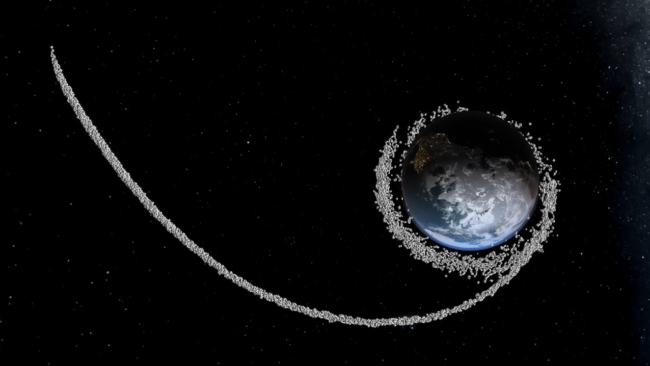
Results of the Moon fragmenting around Earth.
So in short, SPH will improve or make possible simulations of the following:
- Total fragmentation
- Tidal deformation and Roche fragmentation
- Accretion disks / object formation from debris
- Giant-impact hypothesis (moon formation!)
And in the longer term, we hope to apply it elsewhere, including more accurate galaxy collisions and star formation.
What’s Next
As you can see, SPH is already working pretty well within Universe Sandbox. But you can also see that it’s not exactly integrated with everything else yet. The visuals right now are intended solely for debugging purposes, and the transition from our standard planet visuals to the SPH particles is a little rough. Making visuals that look more like molten planets being torn apart will definitely take time, but we have some ideas in mind that we’re excited to explore.
The visuals are just one component of what we’ll need to work on to integrate SPH with Universe Sandbox. Making it work with other complex aspects of the simulation, like the new Surface Grids feature, will be its own can of worms. But we’re no strangers to technical challenges. And since we think SPH is worth experimenting with on its own, we hope to release an early version of it using the debug visuals and let you turn it on if you’re interested in checking it out. We don’t know when this will happen yet, but hopefully not too long into next year.
And hopefully before then, we’ll have a small update ready that will add some oft-requested color customization…
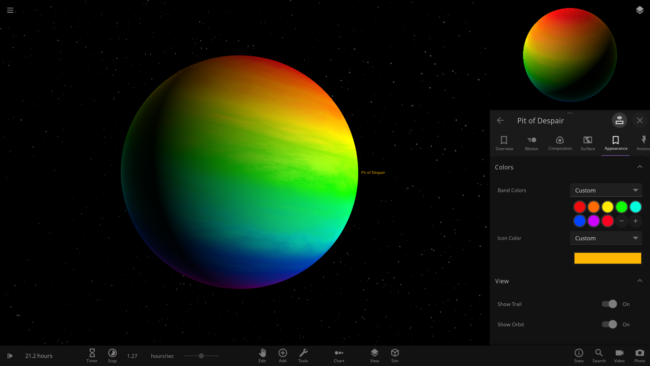
Last Updated: November 14, 2022
Surface Grids & Lasers | Update 24
Nov 22nd
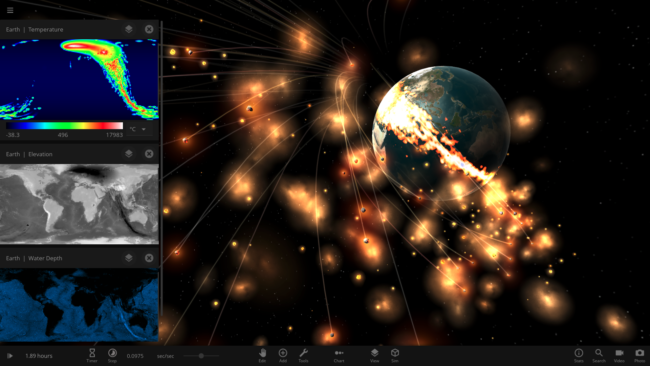
Run Steam to download Update 24, or buy Universe Sandbox via our website or the Steam Store.
Surface Grids & Lasers are here! This is a big update that adds new layers to the simulation and new ways to experiment with planets, moons, and entire systems:
Simulate Surfaces
Surface Grids is a huge, complex feature that simulates the surfaces of planets, moons, and other objects. Every one of these objects now has simulated water levels, water and vapor flow, local temperature, material states like snow and ice, and more.
Vaporize Planets with a Giant Laser
Did we mention that there are lasers now? Whether you want to melt some ice caps or vaporize entire planets, the laser is the right tool for the job: Tools > Laser
And More to Come
This is the first version of Surface Grids; we hope to release many improvements to surface simulation over the coming months.

Check out a full list of What’s New in Update 24
Surface Grids & Lasers | DevLog #12
Nov 6th

Video: Saving an object and its Surface Grids data then adding it to the simulation.
Surface Grids & Lasers are not yet available in any official Universe Sandbox releases. But they are now available in the experimental version of Universe Sandbox! Learn how to take an early look at Surface Grids & Lasers.
If you haven’t seen them yet, check out the previous Surface Grids DevLogs #1, #2, #3, #4, #5, #6, #7, #8, #9, #10, and #11. Keep in mind these DevLogs document a work-in-progress feature. Anything discussed or shown may not be representative of future versions of Surface Grids.
What is Surface Grids? It’s a big, complex feature still in development. It simulates the surfaces of planets, moons, and other objects, adding much more detailed, dynamic, and accurate visuals. And as a bonus, it makes it possible to add tools like lasers, which are essentially just a fun way of heating up localized areas of a surface.
Improving the Experiment
Since we released the first experimental version that included Surface Grids, we’ve released a few updates that have made a lot of improvements and bug fixes. Below are some highlights from the three major areas of the new Surface Grids feature, the interface, simulation, and visuals.
1. Interface improvements
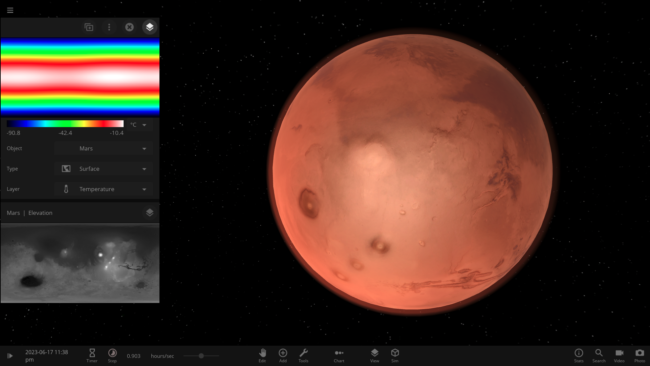
- Better design for map interface
- New map legend
We moved around some buttons, turned others into drop-down menus, cleaned up some settings, and added a brand new color legend for all that wonderful data.
2. Simulation improvements
- Reimplemented tidal heating
- More stable heat diffusion (& new Thermal Diffusivity slider to adjust rate)
- Better water initialization for random planets
- Improved water flow
A lot of the individual simulation improvements, tweaks, and fixes can be harder to notice, because if everything’s working well, then they don’t draw much attention to themselves. Instead, they just work. But if you’ve been following along, hopefully you’ll notice that the surface simulation has been getting smoother and smoother.
3. Visual improvements
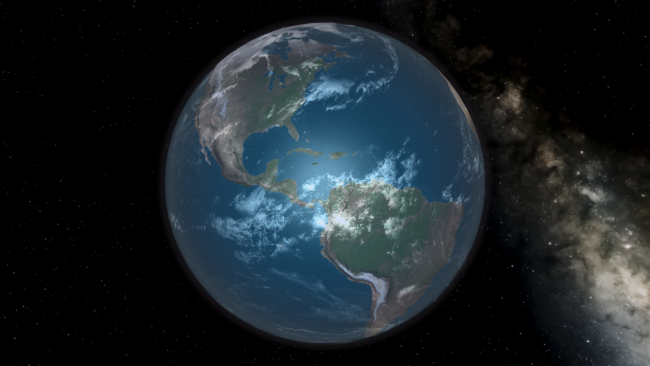
- Improved coastlines
- Improved lighting
- Improved terrain and vegetation rendering
- Improved visual noise (randomness) on ice edges
- Reduced texture seams
- Shallow water no longer fully opaque
Isn’t Earth looking georgeous? (…that’s what we call gorgeous things created by our graphics developer, Georg) On top of all of the visual beautification, which you can see with random planets as well, we’re pretty happy with how coastlines are now looking (these latest changes are not yet in the experimental build). They may not be as accurate as our real life home planet itself, but after lots and lots of tweaking and experimenting, we now have coastlines that are fairly accurate and work well with changing water levels.

Beyond the changes we’ve listed above, we’ve also added support for saving & loading objects, including retaining all of the Grids data (see video at top of post), performance improvements, and dozens of tweaks and bug fixes.
In the last update we also added a short, 15-second performance test that you’ll see pop up when you first run this version of the experimental build. Please run this test so we can learn more about how Surface Grids performs on different hardware!
If you want to stay up to date on the latest changes to the experimental version, join our Discord and check out the #experimental-build channel. We make announcements there whenever there’s an update.
What’s Next
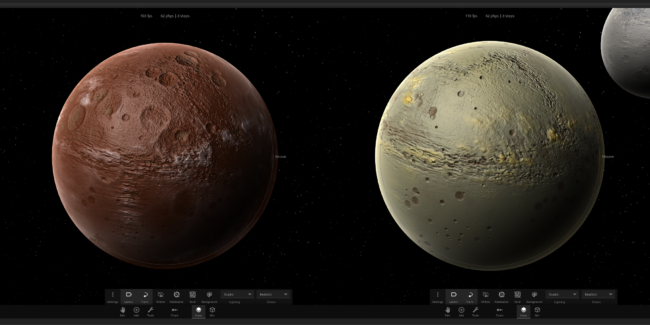
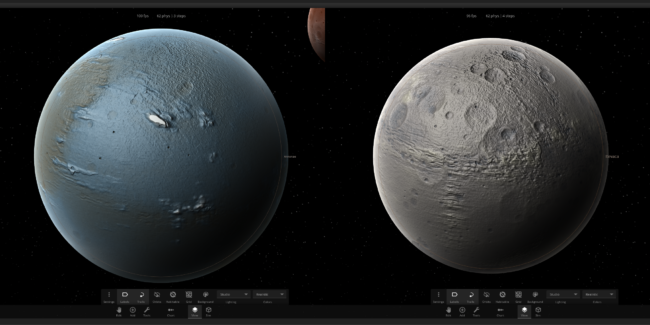
As we continue to update the experimental build, we get closer to the official release of Surface Grids. Like before, this part of development is about balancing our work between continuing with all the other improvements and fixes we’ve had in mind and addressing community feedback as more and more people check it out — please let us know what you think!
Above are screenshots of some of Brendan’s newly generated heightmaps (detailed in DevLog #10) partially implemented in-game. There’s still more work to do on these, but we should hopefully have them in an experimental build soon.
We also are working on a tutorial about terraforming Mars. We’ve seen multiple users point out that terraforming is a lot more complex now, and that’s certainly true. This is easily seen when attempting to terraform Mars, which, it turns out, is a bit more involved than just spraying some water at it. Figuring out how to do it is part of the fun, but there are some tips and tricks that are good to know.
We’re super excited with how Grids is shaping up, and we hope that if you’ve been following along, you can see all the progress we’ve made. We look forward to sharing more. See you in the next DevLog!
Saturn’s New Moons | Update 23.2
Nov 1st
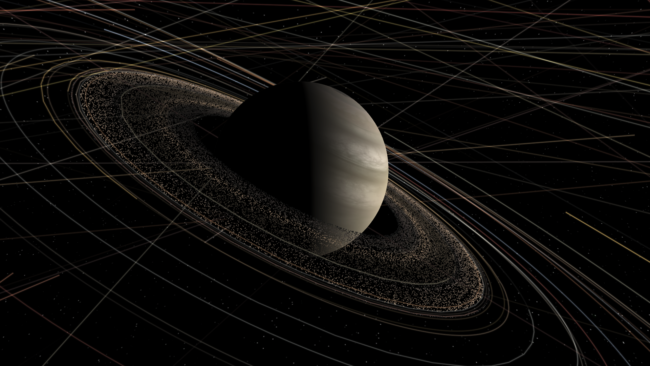
Run Steam to download Update 23.2, or buy Universe Sandbox via our website or the Steam Store.
Introducing the new Moon Champion of the Solar System, with a total of 82 known moons, it’s the great ringed gas giant Saturn!
Take a tour through the discoveries of Saturn’s moons, from the first discovered moon, Titan, in 1655, to the latest discovery of 20 new moons in October 2019:
Home > Guides > Science > History of Saturn’s Moons
With 82 moons, Saturn now has the most known moons, surpassing the previous record holder Jupiter and its 79 known moons.
This update also includes a refresh of our database and Saturn simulations to add its new moons, plus a few smaller fixes and improvements.
Check out a full list of What’s New in Update 23.2
Universe Sandbox is 33% Off — Best Deal Before Price Increase
Oct 19th
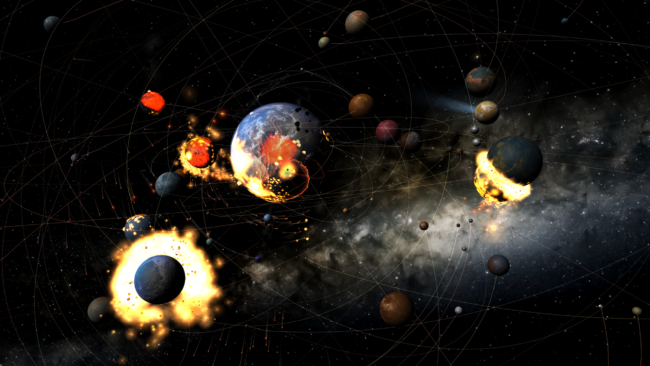
Universe Sandbox is now 33% off on Steam!
This is your last chance to get Universe Sandbox on sale before we raise the price on Tuesday, October 22 to USD $29.99 (localized prices will be raised accordingly). We’ll definitely be on sale again after we raise the price, but this will likely be the best deal for a while.
We announced our plans to raise the price earlier in the summer. This is slightly different than the original plan of raising it once we released Surface Grids & Lasers, but it still fits into the October timeline we mentioned. And while Surface Grids & Lasers aren’t available in any official releases yet, you can try them now in the experimental build!
What is Surface Grids?
It’s the next big, complex feature that is coming to Universe Sandbox. It simulates the surfaces of planets, moons, and other objects, adding much more detailed, dynamic, and accurate visuals.
And as a bonus, it makes it possible to add tools like lasers, which are essentially just a fun way of heating up localized areas of a surface.
Learn more about Surface Grids & Lasers in our latest DevLogs

